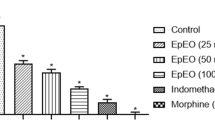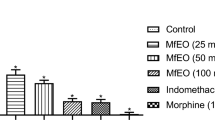Abstract
Plants of the genus Psidium have been employed in “in natura” consumption and agroindustry, and owing to the diversity of phytochemicals, the development of new pharmaceutical forms has received remarkable research interest. In this study, the essential oil obtained from Psidium glaziovianum (PgEO) leaves were evaluated antinociceptive and anti-inflammatory activities were evaluated in mouse models. Initially, PgEO was characterized by gas chromatography–mass spectrometry and gas chromatography with flame ionization detection, and the profile was dominated by sesquiterpene compounds. In the evaluation of acute antinociceptive activity (abdominal contortions induced by acetic acid, formalin, tail immersion, and hot plate tests), PgEO promoted a reduction in nociception in the chemical and thermal models. Additionally, the potential underlying mechanism was investigated using pain pathway blockers, and the results revealed a combined action of opioidergic and muscarinic pathways. The anti-inflammatory potential was confirmed by anti-edematogenic action, reduced cell migration, pro-inflammatory cytokine production, and granuloma formation in chronic processes. This study provides evidence that PgEO can be effective for the treatment of pain and acute and chronic inflammation.







Similar content being viewed by others
Data availability
Not applicable.
References
Baldo BA, Rose MA (2020) The anaesthetist, opioid analgesic drugs, and serotonin toxicity: a mechanistic and clinical review. Br J Anaesth 124(1):44–62
Bjarnason I, Scarpignato C, Holmgren E, Olszewski M, Rainsford KD, Lanas A (2018) Mechanisms of damage to the gastrointestinal tract from nonsteroidal anti-inflammatory drugs. Gastroenterology 154(3):500–514
Calvi GP, Aud FF, Ferraz IDK, Pritchard HW, Kranner I (2017) Analyses of several seed viability markers in individual recalcitrant seeds of Eugenia stipitata McVaugh with totipotent germination. Plant Biol 19(1):6–13
Costa MDCMFD, Silva AGD, Silva APSAD, Lima VLDM, Bezerra-Silva PC, Rocha SKLD, Paiva PMG (2017) Essential oils from leaves of medicinal plants of Brazilian flora: chemical composition and activity against Candida species. Medicines 4(2):27
Drini M (2017) Peptic ulcer disease and non-steroidal anti-inflammatory drugs. Aust Prescr 40(3):91
Ehrnhöfer-Ressler MM, Fricke K, Pignitter M, Walker JM, Walker J, Rychlik M, Somoza V (2013) Identification of 1, 8-cineole, borneol, camphor, and thujone as anti-inflammatory compounds in a Salvia officinalis L. infusion using human gingival fibroblasts. J Agric Food Chem 61(14):3451–3459
Guilhon CC, Raymundo LJ, Alviano DS, Blank AF, Arrigoni-Blank MF, Matheus ME, Fernandes PD (2011) Characterisation of the anti-inflammatory and antinociceptive activities and the mechanism of the action of Lippia gracilis essential oil. J Ethnopharmacol 135(2):406–413
Khatun A, Imam MZ, Rana MS (2015) Antinociceptive effect of methanol extract of leaves of Persicaria hydropiper in mice. BMC Complement Altern Med 15(1):63
Kim T, Song B, Cho KS, Lee IS (2020) Therapeutic potential of volatile terpenes and terpenoids from forests for inflammatory diseases. Int J Mol Sci 21(6):2187
Kotas ME, Medzhitov R (2015) Homeostasis, inflammation, and disease susceptibility. Cell 160(5):816–827
Landrum LR (2017) The genus Psidium (Myrtaceae) in the state of Bahia. Herbarium, Natural History Collections, School of Life Sciences, Arizona State University, Brazil
Lapa AJ, Souccar C, Lima-Landman TR, Castro MAS, Lima TCM (2008) Plantas medicinais: métodos de avaliação da atividade farmacológica. Sociedade Brasileira de Plantas Medicinais, 144
Le Bars D, Gozariu M, Cadden SW (2001) Animal models of nociception. Pharmacol Rev 53(4):597–652
Lenardão EJ, Savegnago L, Jacob RG, Victoria FN, Martinez DM (2016) Antinociceptive effect of essential oils and their constituents: an update review. J Braz Chem Soc 27(3):435–474
Liapi C, Anifantis G, Chinou I, Kourounakis AP, Theodosopoulos S, Galanopoulou P (2007) Antinociceptive properties of 1, 8-cineole and β-pinene, from the essential oil of Eucalyptus camaldulensis leaves, in rodents. Planta Med 73(12):1247–1254
Macêdo DG, de Almeida Souza MM, Morais-Braga MFB, Coutinho HDM, dos Santos ATL, Machado AJT, de Menezes IRA (2020) Seasonality influence on the chemical composition and antifungal activity of Psidium myrtoides O Berg. S Afr J Bot 128:9–17
Maleki SJ, Crespo JF, Cabanillas B (2019) Anti-inflammatory effects of flavonoids. Food Chem 299:125124
Martins AOBPB, Rodrigues LB, Cesário FRAS, de Oliveira MRC, Tintino CDM, e Castro FF, Wanderley AG (2017) Anti-edematogenic and anti-inflammatory activity of the essential oil from Croton rhamnifolioides leaves and its major constituent 1, 8-cineole (eucalyptol). Biomed Pharmacother 96:384–395
Nascimento KF, Moreira FMF, Santos JA, Kassuya CAL, Croda JHR, Cardoso CAL, Formagio ASN (2018) Antioxidant, anti-inflammatory, antiproliferative and antimycobacterial activities of the essential oil of Psidium guineense Sw. and spathulenol. J Ethnopharmacol 210:351–358
Oliveira AM, doNascimento MF, Ferreira MRA, deMoura DF, dosSantosSouza TG, daSilva GC, Napoleão TH (2016) Evaluation of acute toxicity, genotoxicity and inhibitory effect on acute inflammation of an ethanol extract of Morus alba L. (Moraceae) in mice. J Ethnopharmacol 194:162–168
Oliveira AM, de Luna Freire MO, da Silva WAV, Ferreira MRA, Paiva PMG, Soares LAL, Napoleão TH (2018) Saline extract of Pilosocereus gounellei stem has antinociceptive effect in mice without showing acute toxicity and altering motor coordination. Regul Toxicol Pharmacol 95:289–297
Raja SN, Carr DB, Cohen M, Finnerup NB, Flor H, Gibson S, Vader K (2020) The revised International Association for the Study of Pain definition of pain: concepts, challenges, and compromises. Pain 161(9):1976–1982
Santos FA, Rao VSN (2000) Antiinflammatory and antinociceptive effects of 1,8-cineole a terpenoid oxide present in many plant essential oils. Phytother Res 14(4):240–244
Santos FA, Rao VSN, Silveira ER (1996) Naloxone-resistant antinociceptive activity in the essential oil of Psidium pohlianum Berg. Phytomedicine 3(2):197–201
Santos FA, Rao VSN, Silveira ER (1998) Investigations on the antinociceptive effect of Psidium guajava leaf essential oil and its major constituents. Phytother Res 12(1):24–27
Sekhar NC, Jayasree T, Ubedulla S, Dixit R, M VS (2014) Evaluation of antinociceptive activity of aqueous extract of bark of Psidium guajava in albino rats and albino mice. J Clin Diagn Res 8(9):01
Siani AC, Souza MC, Henriques MG, Ramos MF (2013) Anti-inflammatory activity of essential oils from Syzygium cumini and Psidium guajava. Pharm Biol 51(7):881–887
Souza TDS, da Silva Ferreira MF, Menini L, de Lima Souza JRC, Parreira LA, Cecon PR, Ferreira A (2017) Essential oil of Psidium guajava: influence of genotypes and environment. Sci Hortic 216:38–44
Souza SR, Petícia DNE, Alencar DMI, Sales VDS, Brito PA, Mendes DLG, Vieira NB (2019) Antinociceptive activity of the Psidium brownianum Mart ex DC leaf essential oil in mice. Food Chem Toxicol 135:111053
Swingle KF, Shideman FE (1972) Phases of the inflammatory response to subcutaneous implantation of a cotton pellet and their modification by certain antiinflammatory agents. J Pharmacol Exp Ther 183(1):226–234
Tasneem S, Liu B, Li B, Choudhary MI, Wang W (2019) Molecular pharmacology of inflammation: medicinal plants as anti-inflammatory agents. Pharmacol Res 139:126–140
Tuler AC, Carrijo TT, Peixoto AL, Garbin ML, da Silva Ferreira MF, Carvalho CR, Clarindo WR (2019) Diversification and geographical distribution of Psidium (Myrtaceae) species with distinct ploidy levels. Trees 33(4):1101–1110
Türkez H, Aydın E (2016) In vitro assessment of cytogenetic and oxidative effects of α-pinene. Toxicol Ind Health 32(1):168–176
Winter CA, Risley EA, Nuss GW (1962) Carrageenin-induced edema in hind paw of the rat as an assay for antiinflammatory drugs. Proc Soc Exp Biol Med 111(3):544–547
Acknowledgements
The authors express their gratitude to the Coordenação de Aperfeiçoamento de Pessoal de Nível Superior (CAPES; Finance Code 001) and to the Conselho Nacional de Desenvolvimento Científico e Tecnológico (CNPq) for research grants (DMAFN, THN, MTSC). WKC and MFN would like to thank CNPq for graduate scholarship. AMO would like to thank FACEPE (BFP-0122-4.03/19) for the post-doctoral scholarship. We thank the Paus dóia community for their welcome in collecting botanical material.
Funding
Fuding was provided by Conselho Nacional de Desenvolvimento Científico e Tecnológico (CNPq), Coordenação de Aperfeiçoamento de Pessoal de Nível Superior (CAPES; Finance Code 001) and the Fundação de Amparo à Ciência e Tecnologia do Estado de Pernambuco (FACEPE).
Author information
Authors and Affiliations
Corresponding author
Ethics declarations
Conflict of interest
The authors declare that they have no known competing financial interests or personal relationships that could have appeared to influence the work reported in this paper.
Additional information
Publisher's Note
Springer Nature remains neutral with regard to jurisdictional claims in published maps and institutional affiliations.
Rights and permissions
About this article
Cite this article
Costa, W.K., do Nascimento, M.F., dos Santos, C.R.B. et al. Oral administration of essential oil from Psidium glaziovianum Kiaersk leaves alleviates pain and inflammation in mice. Inflammopharmacol 30, 599–607 (2022). https://doi.org/10.1007/s10787-022-00940-0
Received:
Accepted:
Published:
Issue Date:
DOI: https://doi.org/10.1007/s10787-022-00940-0




